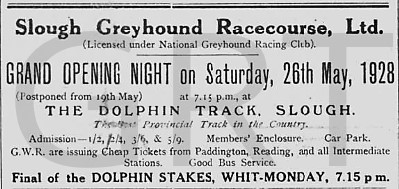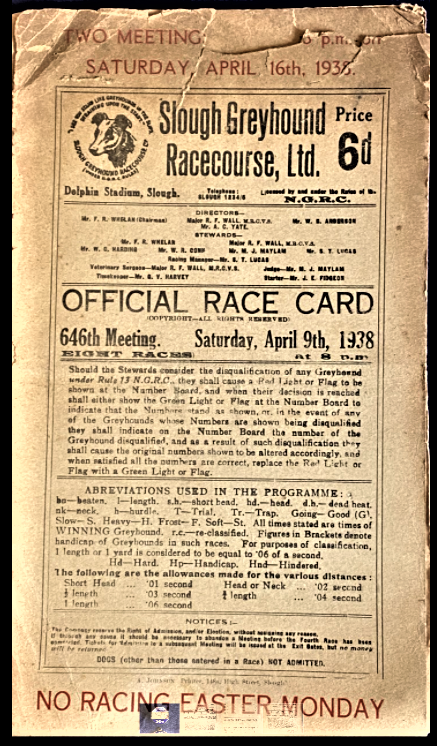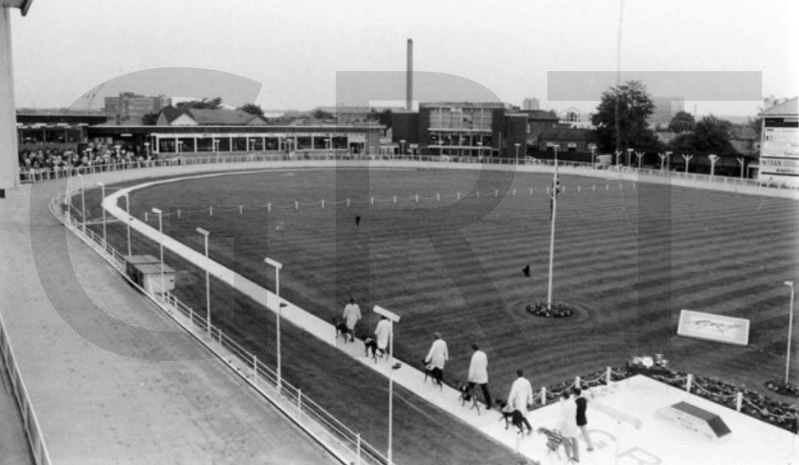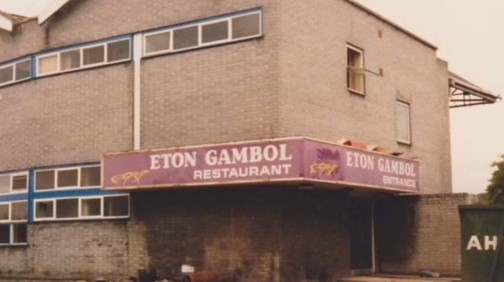The Dolphin Stadium, Uxbridge Road, Slough, Buckinghamshire.
POSTCODE———————————-SL1 1SU
LOCATED————————————About half a mile east of Slough town centre on Uxbridge Road near to were the Premier Inn lies now.
ORIGINAL SITE—————————–Grazing land before becoming a football ground.
DATE CONSTRUCTED——————–1890 as a Football ground.
DATE VENUE OPENED——————-Late 1800’s.
Meaning other sports may have taken place prior to the arrival of Greyhound Racing.
FIRST MEETING—————————–May 26th 1928.
Greyhound Racing only.
LICENSED OR INDEPENDENT———-NGRC.
All venues covered would have to be licensed with the government, licensed suggested in this section would refer to tracks operating under NGRC Rules.
INSIDE OR OUTSIDE HARE TYPE——Inside Sumner.
Please note that the Electric Hare suggested is only a guidance, and would have been in operation for a certain amount of time at this venue. Although it is not necessarily guaranteed that it was operational all the time, as other types of lure may have been used and updated as time progressed.
DISTANCES———————————–442, 625 and 807 metres.
Please note that most racing venues distances had become varied throughout the years, the ones given above were at once point set and offers only a guidance to the track size.
CIRCUMFERENCE—————————365 metres.
Please note that alterations at most racing venues throughout its existence would see that the circumference of the track would vary, the one shown above offers only a guidance to the track size.
BIG RACE NAMES—————————The Ben Trueman Sprint and Stayers Trophy, The Buckinghamshire Cup and The Scurry GOLD Cup transferred to Slough after the closure of Clapton.
STADIUM SHARED WITH——————Slough Town Football Club up to 1974.
LAST MEETING——————————-March 21st 1987.
Greyhound Racing only.
STADIUM CLOSURE DATE—————-March 1987.
Meaning other sports may have taken place after Greyhound Racing had ceased.
STADIUM DEMOLITION——————-1987
BUILT ON SITE——————————-Originally a Co-oP but is now pinpointed by a Morrisons Superstore and its car park.
In some cases, structure’s that originally covered the venue after the stadium had been demolished, may have been themselves demolished too, so the one described is more likely to be the one which now presently covers the site.
EVIDENCE LEFT TODAY——————-Nothing known of.
FURTHER COMMENTS——————–None



























Up until the 1980’s one of the most attended greyhound tracks in London was the Slough Greyhound Stadium. Known originally as the Dolphin Stadium for reasons later described, it had virtually served its entire life as an NGRC purpose track for nearly sixty years before being sold off for the site to be redeveloped.
It was located just off Uxbridge Road, about half a mile east of Sloughs town centre and almost next door to the once Dolphin Public House. The first signs of sporting activities on the site were during the 19th century, a period which had witnessed gatherings for cricket, football and bowls. But it was in 1890 that the site began to develop into a more enclosed venue after it had been purchased by George Bennett Snr, the man behind the formation of Slough Football Club.
The venue became known as the Dolphin Ground named after the Dolphin Public House, which incidentally became the ownership of Mr Bennett in 1914. But it was in 1928 that more changes came to The Dolphin Ground after Mr Bennet had been impressed by the new sport of greyhound racing, and immediately invested in turning the venue into a greyhound track.
With the backing from the GRA, a track was laid out around the football pitch, complete with a hare system that had strangely enough been imported from a company based in the German city of Cologne. The Dolphin Stadium staged its first meeting on the 26th of May 1928, when over 1,000 spectators attended a meeting that would witness races being run under rules similar to those of the NGRC. But in 1936 Mr Bennet sold the stadium to The New Clapton Stadium Company, who immediately named it The Slough Greyhound Stadium.
The outbreak of the Second World War brought a temporary halt to all sporting activities at the venue. Yet within weeks the greyhounds were back, albeit under new war regulations which would allow meetings to be run during daylight hours only. But the return of the dogs came at a price, as the football club had been forced to leave The Dolphin due to them clashing on Saturday afternoons. Amateur Football eventually returned to the Dolphin once the war hostilities had ceased.
In 1966 the stadium changed hands once again this time with the new owners being The Greyhound Racing Association. The track itself had a 365-metre circumference, which created distances of 442, 625 and 807 metres, with an inside Sumner hare being used as the lure. Slough had its fair share of staging big events such as the Ben Trumann Sprint, The Stayers Trophy and the Buckinghamshire Cup which was first introduced in 1949. Yet its most famous was The Scurry Gold Cup, run over the 442-metre trip having been introduced in 1974 after the closure of The Clapton Stadium. 1974 brought another couple of changes, firstly with the outgoing of Slough Town Football Club, who incidentally moved into a new purpose-built stadium at Wexham Park, and secondly the introduction of a brief spell of American Football.
The 1980’s witnessed a decline in attendances and also a rise in running costs, which contributed to the stadium being sold to developers for seven million during April 1985. Slough Stadium staged its final meeting on the 21st of March 1987, and within months the stadium had been totally demolished.
Today, the site on were the stadium once lay has totally been transformed, even the Dolphin Public House is no longer there having been replaced by the more modern Premier Hotel. The Co-op that once replaced the stadium has also gone, with a Morrisons Superstore and its car park now covering the site.
Memorabilia for this track is required for this page, if you can help please contact me.

Recent Comments